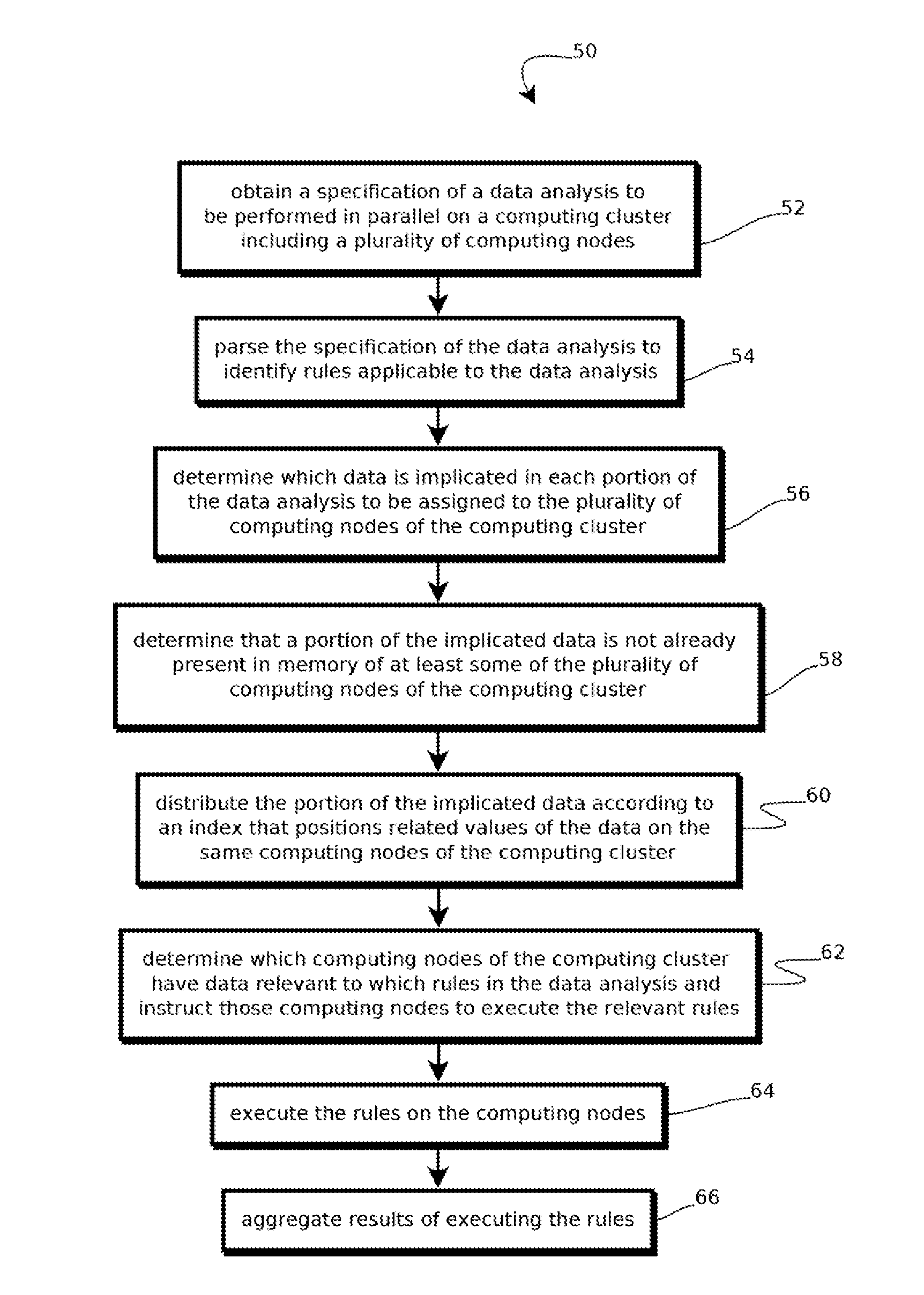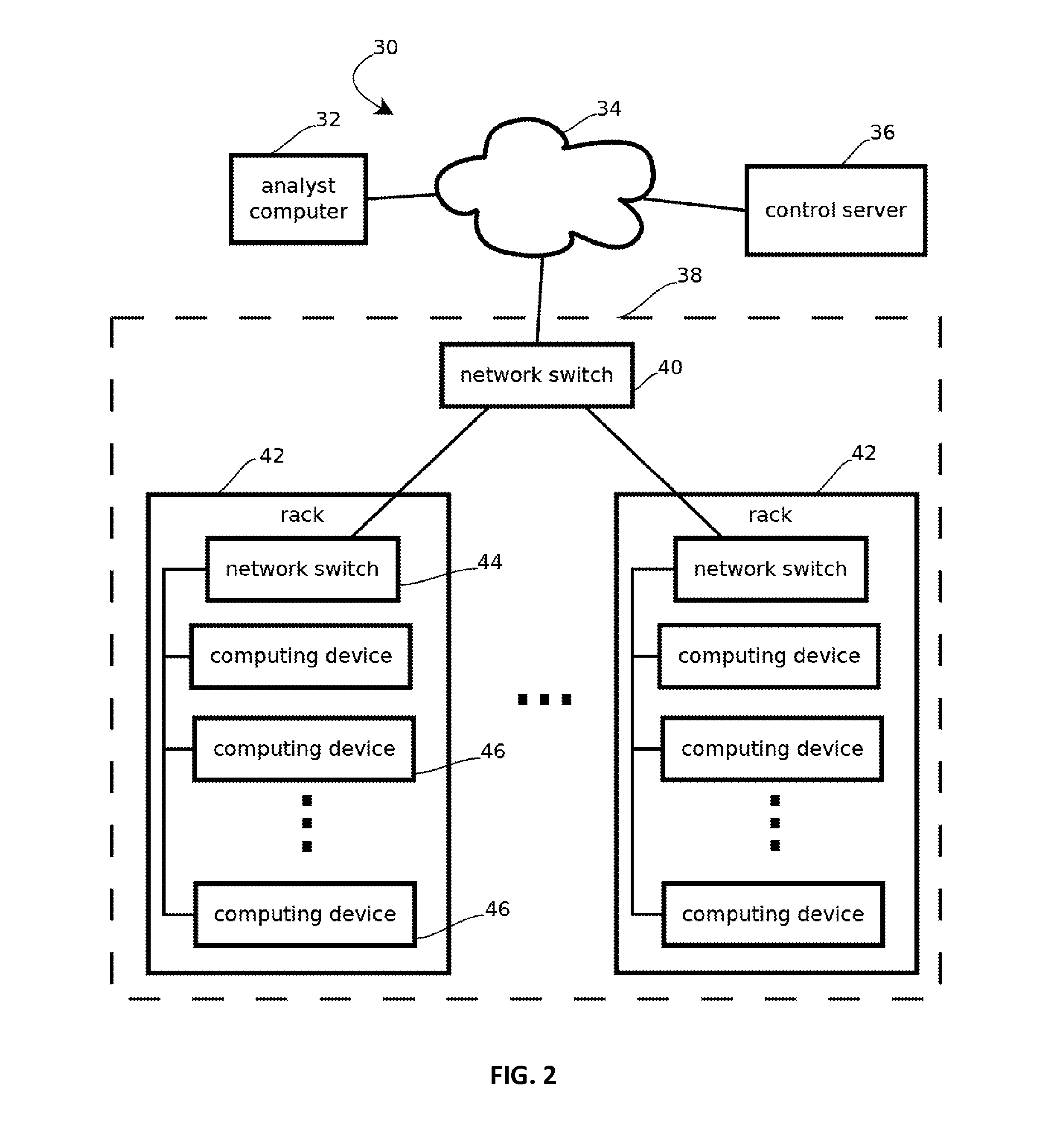Scripting distributed, parallel programs
a distributed, parallel program technology, applied in the field of data analysis, can solve the problems of not being trained on how to manipulate large data sets quickly on massively parallel computing architectures, and often not being able to perform coarser analysis on smaller data sets,
- Summary
- Abstract
- Description
- Claims
- Application Information
AI Technical Summary
Benefits of technology
Problems solved by technology
Method used
Image
Examples
example 1
[0035]
Coverage Scoring Moderule “Autozone Customer” for Retail->Auto_Parts_Stores->Autozone { use coverage_scoring threshold 0.01 denominator Total->Location; use time_periods Mon-Fri 7:30-10:00, Sat 7-10, Sun 8-10; using taxonomy “piq->Location Tags->chain” { yield autozone; }}-- use (global scope) vs. using (local scope)-- time periods can be human-readable or numeric or ISO8601-- each rule must have exactly one yield statement-- omission of time_periods defaults to all
[0036]In some cases, the script may include reserved terms, like “rule”“for”“use” and “yield” that are recognized by the parser and determine the structure of the AST. In some cases, the script may specify a MapReduce job that selects users who have visited a given retailer's geographic location (e.g., as indicated by overlaid polygons like those described above) during certain hours. In some embodiments, a yield command may assign a responsive data set to a variable that may be referenced in other operations on t...
example 2
[0037]
Ratio Scoring Moderule “Race” for Demographic->Race->, { use time_periods all except $am_biz_hours, $pm_biz_hours, $weekday_lunch; using taxonomy Census->Population->Race->Total { use ratio_scoring “White Alone” AS White, “Black Or Africans American Alone” AS “African American”, “American Indian And Alaska Native Alone” AS “American Indian”, “Asian Alone” AS Asian, “Native Hawaiian And Other Pacific Islander Alone” AS Hawaiian, “Two Or More Races” AS Mixed { yield White, “African American”, “American Indian”, Asian, Hawaiian, Mixed; } }}-- rule can yield multiple expressions-- time periods can be specified subtractively
example 3
[0038]
Score Summation Through Explicit Combinationrule “TV Viewership of A&E” forTV_Viewership->Channel->A_and_E { use time_periods all except $am_biz_hours, $pm_biz_hours, $weekday_lunch; using taxonomy “RENTRAK->TV_Viewership->Channel->A_and_E” { combine AS combined_score { 12AM > 8 => (12AM / 10.0) * 0.0515; 1AM > 8 => (1AM / 10.0) * 0.0376; 2AM > 8 => (2AM / 10.0) * 0.0296; 3AM > 8 => (3AM / 10.0) * 0.0215; 4AM > 8 => (4AM / 10.0) * 0.0183; 5AM > 8 => (5AM / 10.0) * 0.0183; 6AM > 8 => (6AM / 10.0) * 0.0255; 7AM > 8 => (7AM / 10.0) * 0.0312; 8AM > 8 => (8AM / 10.0) * 0.0317; 9AM > 8 => (9AM / 10.0) * 0.0302; 10AM > 8 => (10AM / 10.0) * 0.0306; 11AM > 8 => (11AM / 10.0) * 0.0312; 12PM > 8 => (12PM / 10.0) * 0.0322; 1PM > 8 => (1PM / 10.0) * 0.0325; 2PM > 8 => (2PM / 10.0) * 0.0331; 3PM > 8 => (3PM / 10.0) * 0.034; 4PM > 8 => (4PM / 10.0) * 0.0408; 5PM > 8 => (5PM / 10.0) * 0.047; 6PM > 8 => (6PM / 10.0) * 0.0521; 7...
PUM
 Login to View More
Login to View More Abstract
Description
Claims
Application Information
 Login to View More
Login to View More - R&D
- Intellectual Property
- Life Sciences
- Materials
- Tech Scout
- Unparalleled Data Quality
- Higher Quality Content
- 60% Fewer Hallucinations
Browse by: Latest US Patents, China's latest patents, Technical Efficacy Thesaurus, Application Domain, Technology Topic, Popular Technical Reports.
© 2025 PatSnap. All rights reserved.Legal|Privacy policy|Modern Slavery Act Transparency Statement|Sitemap|About US| Contact US: help@patsnap.com



